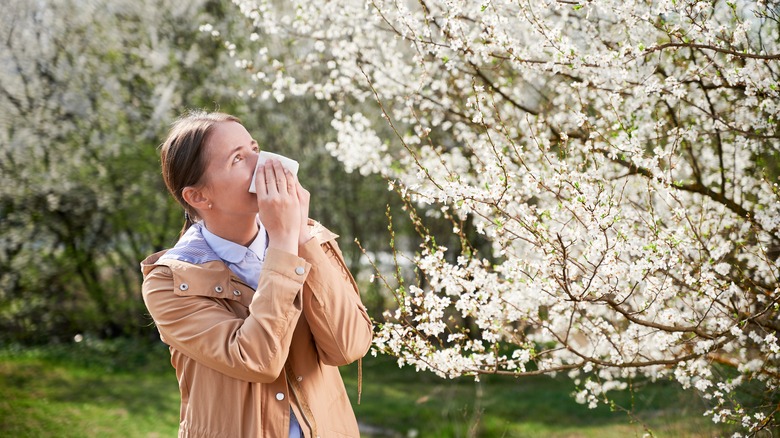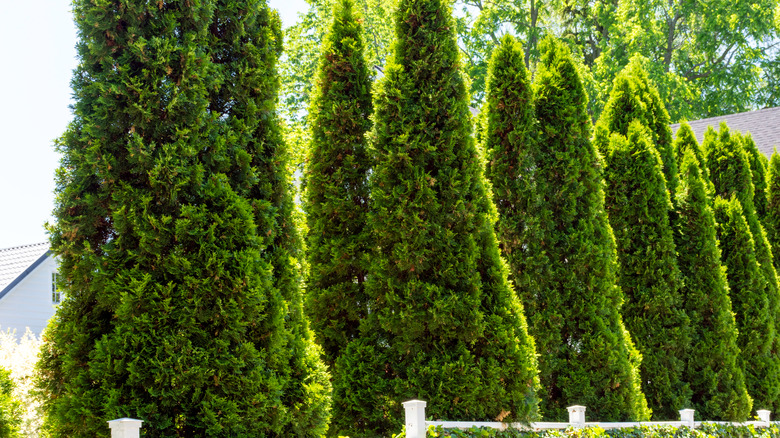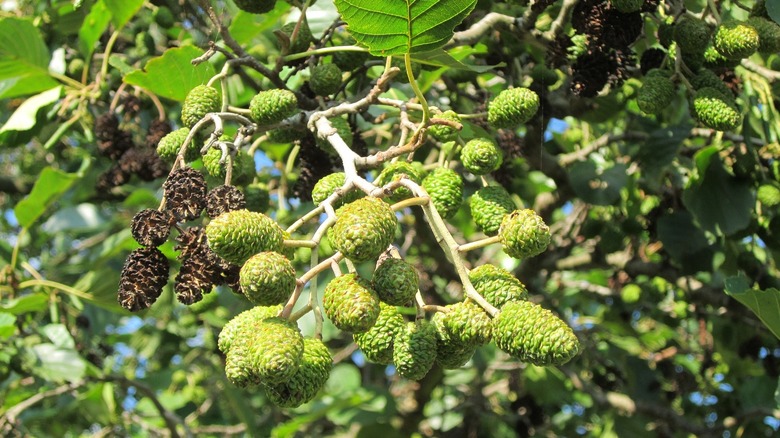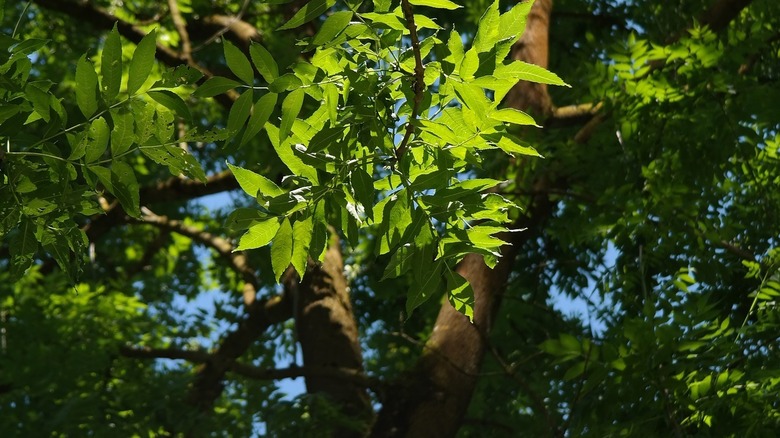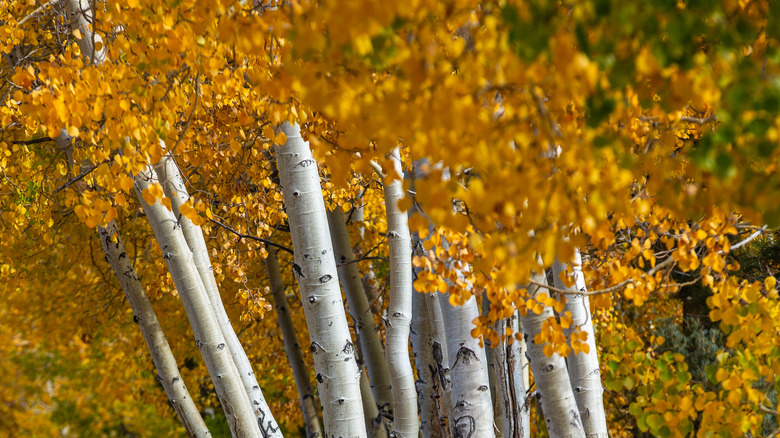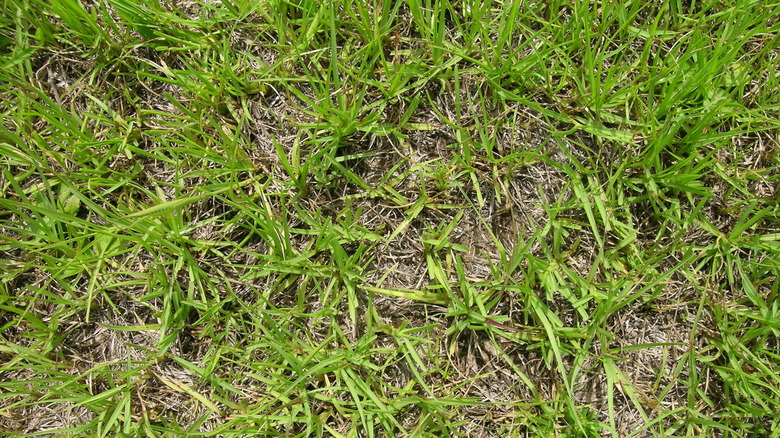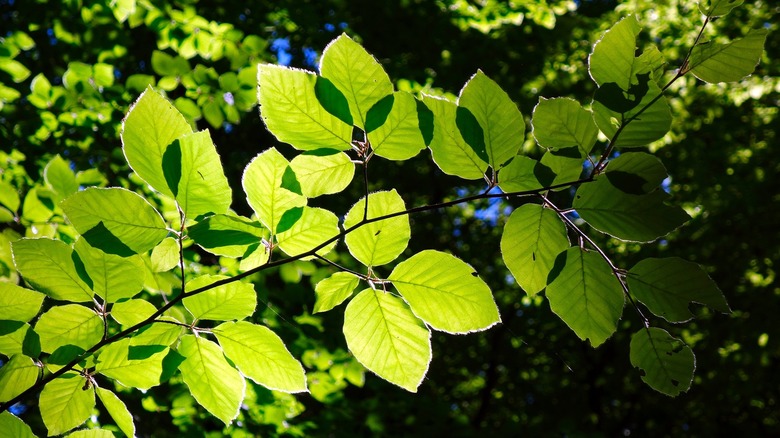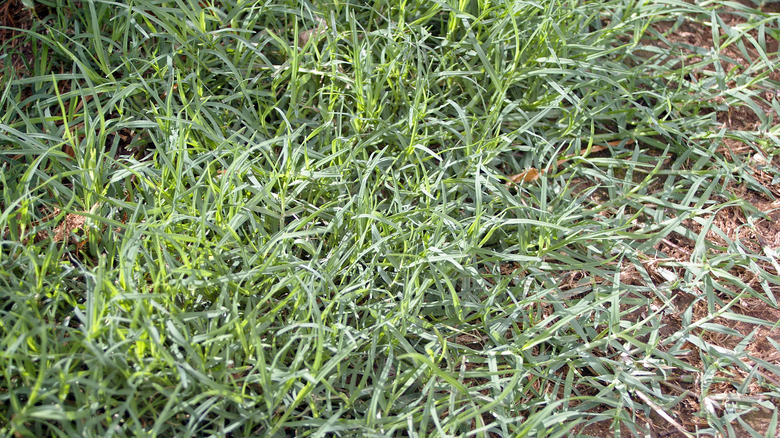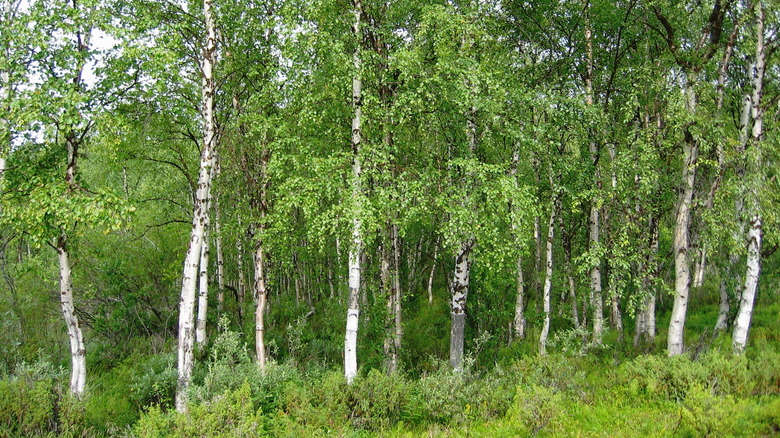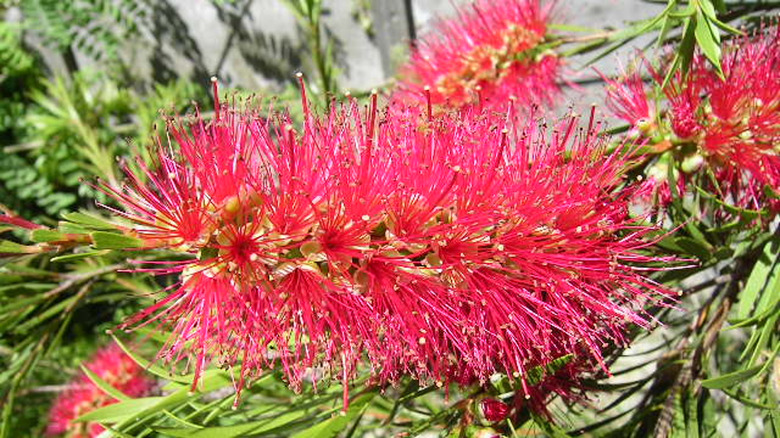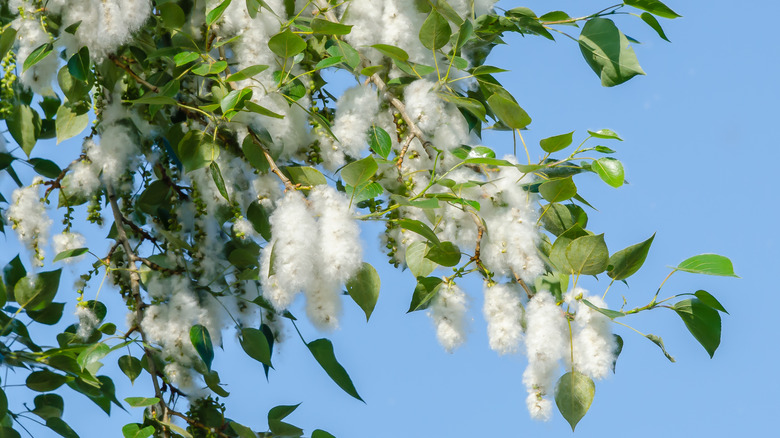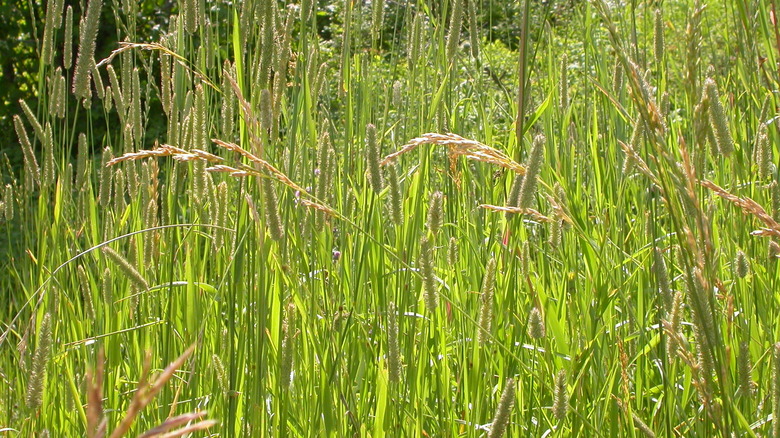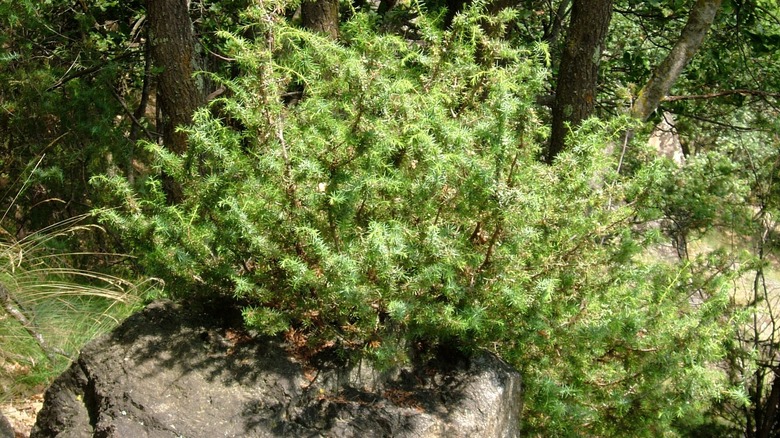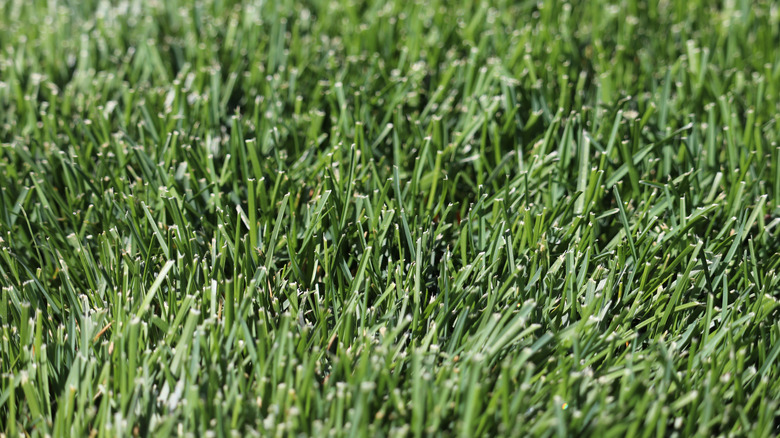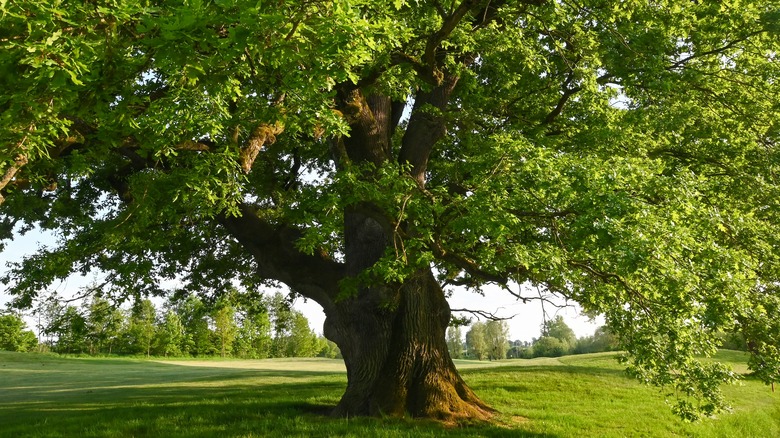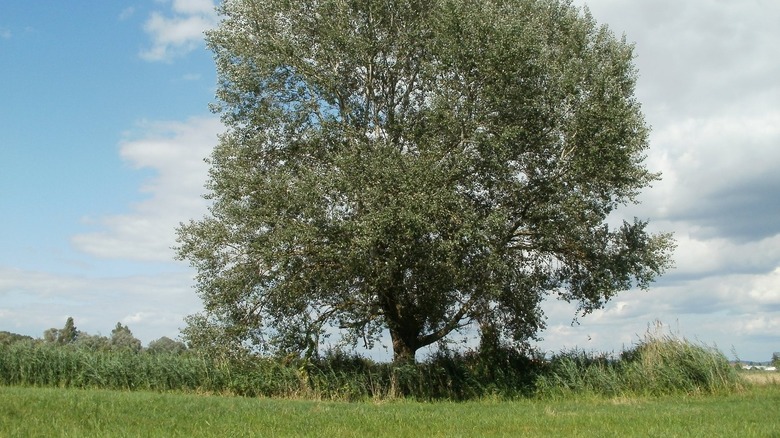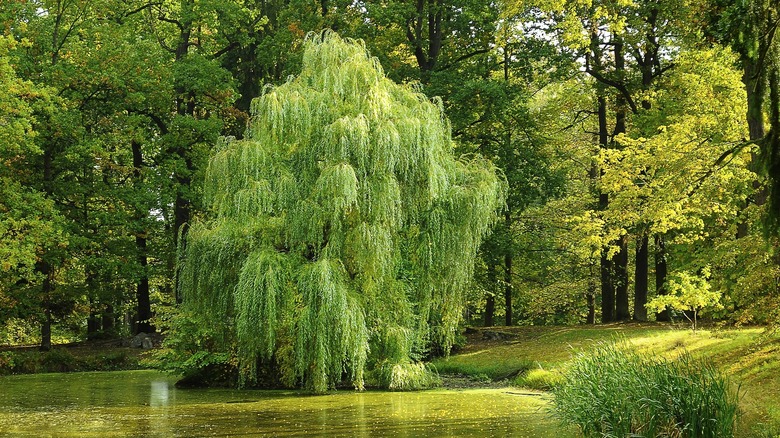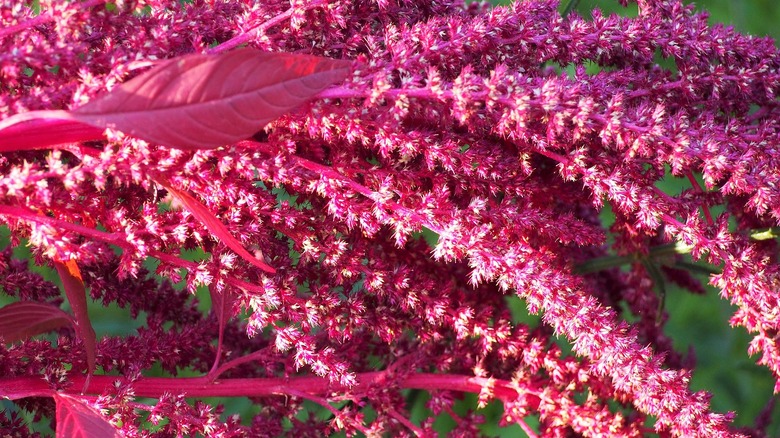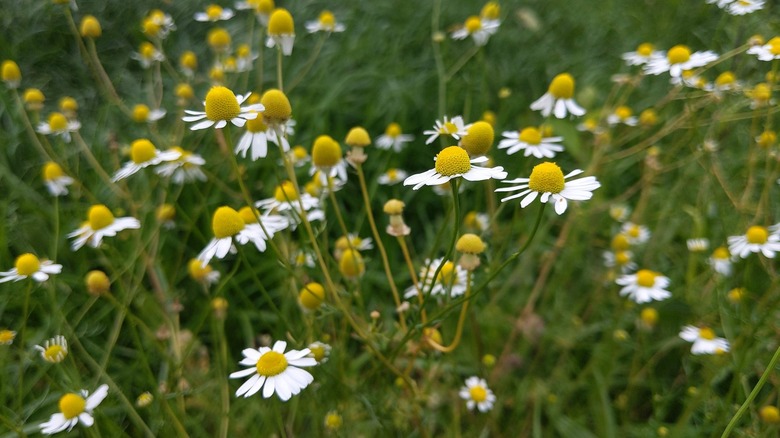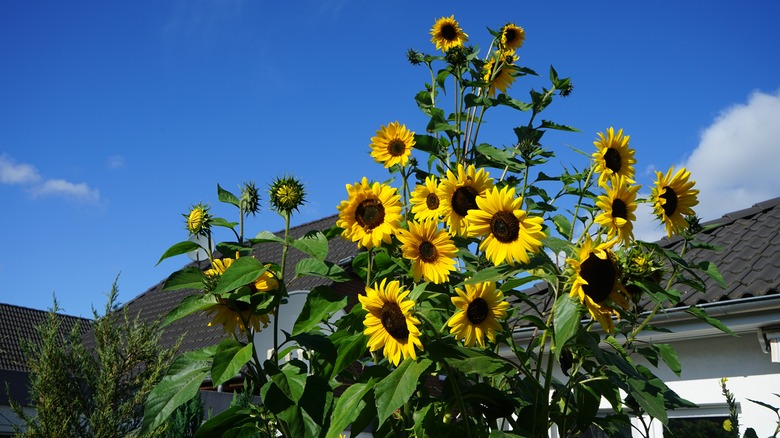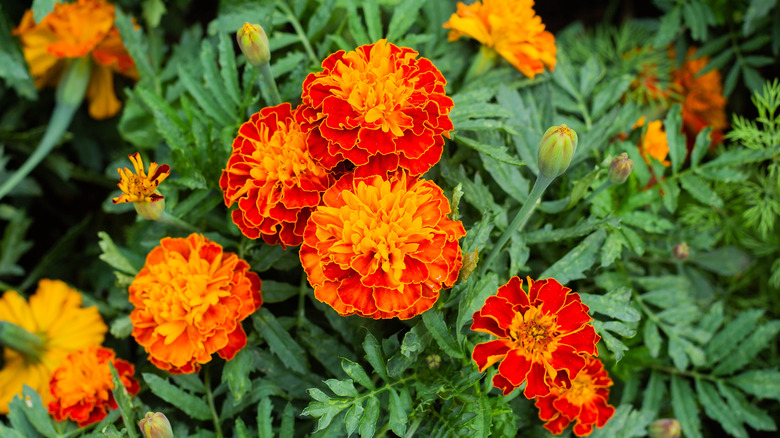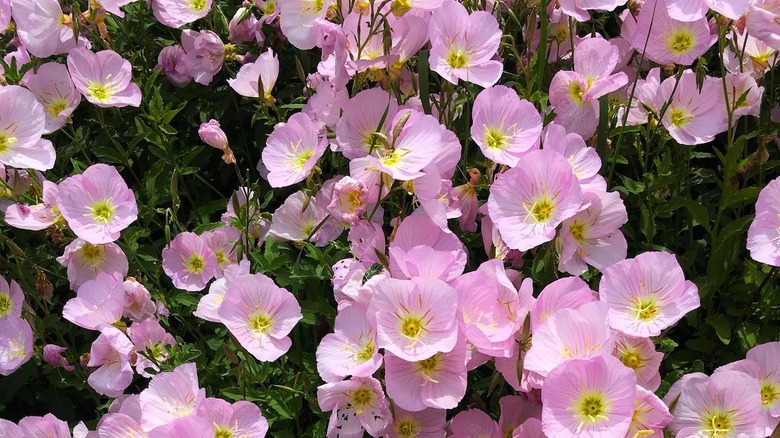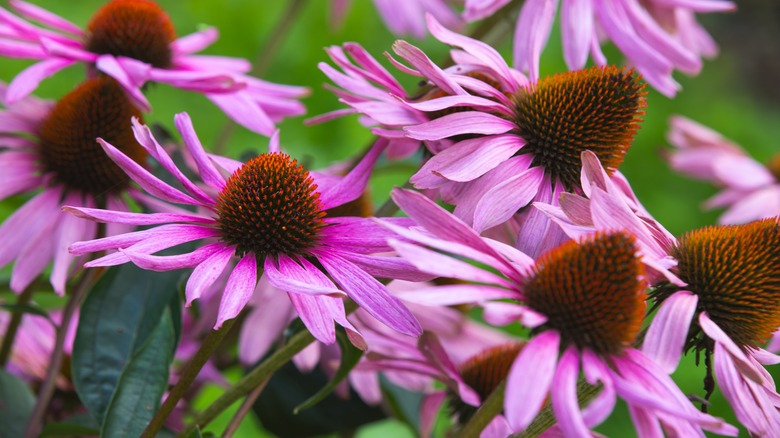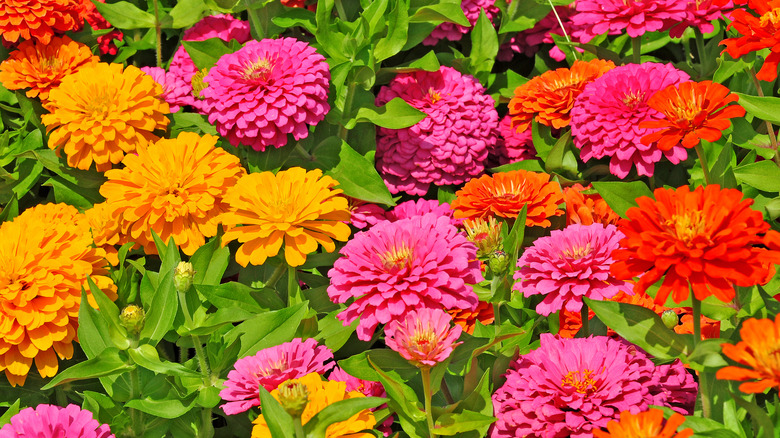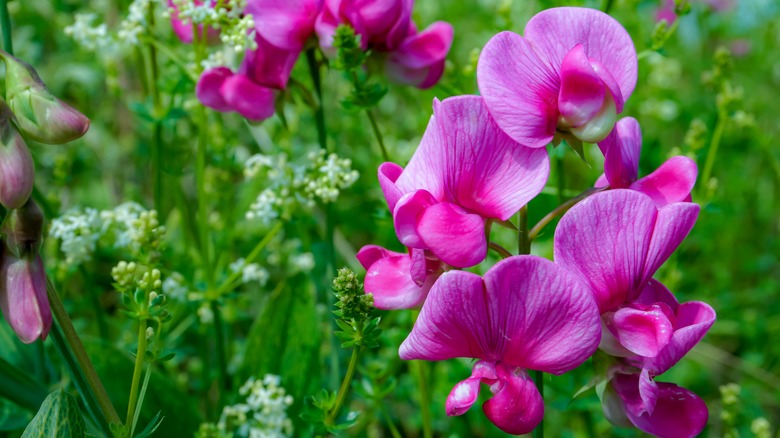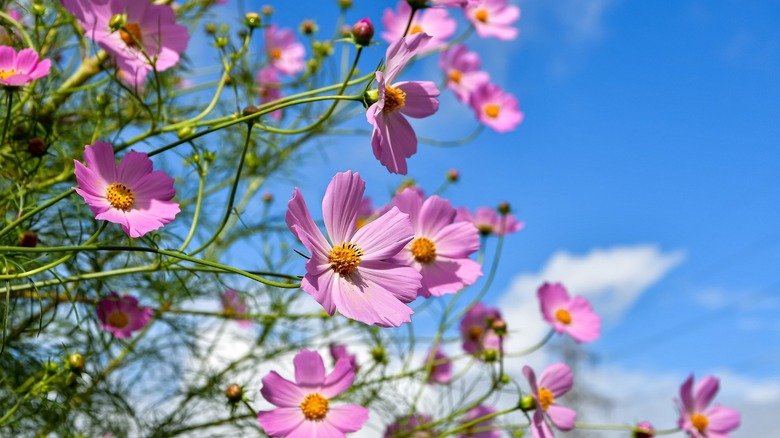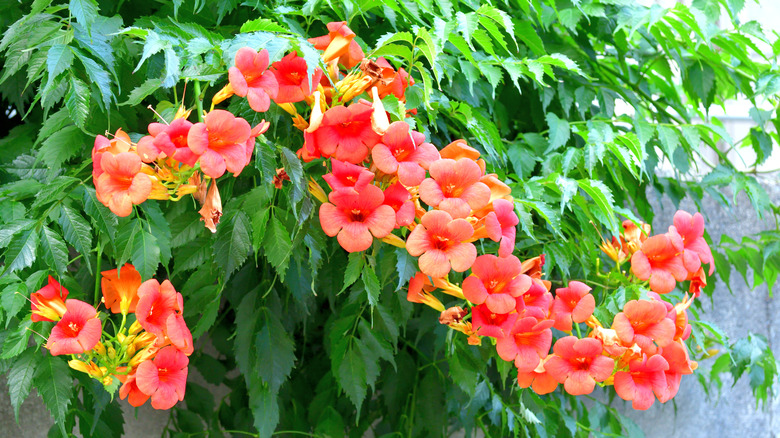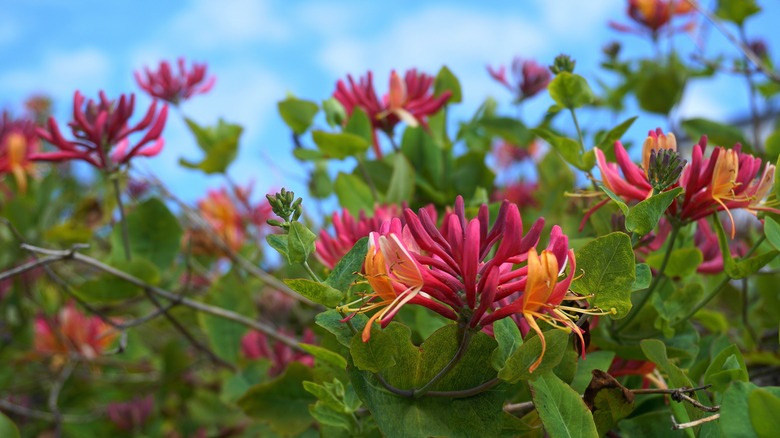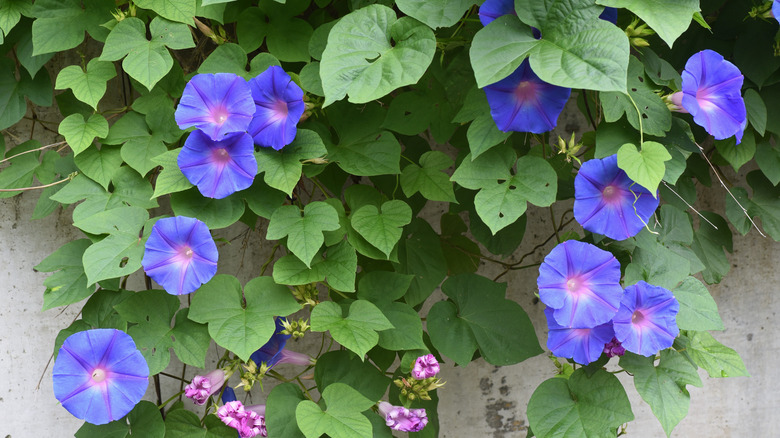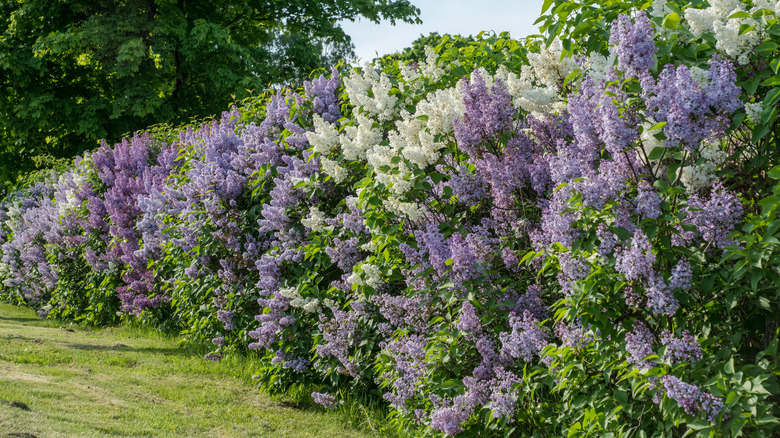If You Deal With Allergies, You're Really Going To Want To Avoid These Plants
When choosing the kind of greenery you want in and around your home, you may need to ensure the plants are safe to have around. Although there are plenty of plants that are ideal for people with allergies, there are also ones you should absolutely avoid. The latter are also ones you might want to get rid of if they're already in your yard. Frankly, millions of people in the United States deal with seasonal allergies caused by pollen from flowers, trees, shrubs, weeds, and more. These plants are obviously the ones you need to steer clear of (among a few others) if you're one of those unfortunate allergy sufferers.
On the topic of removing allergy-sparking plants, Thomas Ogren, author of "The Allergy-Fighting Garden," told Allergic Living, "Any type of foundation plants that are underneath bedroom windows are really crucial, as well as plants closest to doors." Of course, before you start ripping out anything that happens to be growing around your home, you first need to figure out what actually needs to go. As Ogren noted, "I would try to identify the very worst plants in the yard, if indeed there were any."
To do that, you need to be aware of what kind of flowers, shrubs, grasses, and trees might be triggering your allergies. Although you may find some more problematic than others, there are a few plants you should definitely avoid if you want to be safe.
Arborvitae trees
Arborvitae (Thuja) are evergreen conifer trees that can grow into tall columns of stunning greenery. Although that means they can take a place of pride in your yard or even line your entire property, they can also cause issues for those who have allergies. The tall plants can specifically be problematic for anyone who is sensitive to trees in the cypress family, which includes arborvitae. Producing allergy-sparking pollen during spring, it can be weeks before the trees stop giving off the powder-like substance that may be the cause of your sneezing and watery eyes.
Alder trees and shrubs
Found in many areas across the country, alder (Alnus) trees and shrubs are deciduous delights — that is, unless you have allergies. Although there are various kinds of alder, they all rely on pollen that becomes airborne and travels with the help of the wind. This results in a dire and incredibly uncomfortable situation for those who face allergies as the rather potent pollen is difficult to avoid once it's in the air around your home. This means you shouldn't plant alder and may need to remove it if you find it on your property.
Ash trees
There are various kinds of ash trees (Fraxinus) you might come across, including green ash, black ash, blue ash, and white ash. That's not to mention California ash, Carolina ash, European ash, and quite a few others. While this means it might take a little more time to identify exactly what kind of ash you may have in your yard, it's very likely your allergies will be triggered by all ash trees. Pollinating in spring, which is when they'll become a problem, the exact end of their season depends on where you live.
Aspen trees
You're more likely to spot American aspens (Populus tremuloides) than any other trees thanks to the fact that they're so common in the U.S. Their prevalence is also, in part, why they can be such a nuisance for allergy sufferers. A stunning tree that puts on a show during the fall, aspen boasts golden leaves famous for fluttering. That's why the tree is also known as Trembling Aspen or Quacking Aspen. If you suffer from allergies and hear any of these names when moving into a new abode or planning your landscape, then you may need to veto the allergy-triggering trees.
Bahiagrass
Bahia (Paspalum notatum) may primarily be found in Southern areas, however, allergies caused by grass pollen affect across the U.S. Responsible for letting off the substance that's light and travels easily through the air, you may find yourself reacting to the pollen from bahiagrass from April right on through to July. Clearly not something you want in your yard, it's not even a good idea to have it at a little distance since the pollen can travel quite a way before reaching you and causing an unfortunate reaction.
American beech trees
American beech (Fagus grandifolia) take their time when it comes to growing into large trees, which means they can be found in the same yards for years. Although that's wonderful for anyone who loves their gorgeous leaves and stately presence, it's not as ideal for those with allergies. Another plant that creates pollen that's then carried off by the wind, it may not be the beech pollen alone that causes you to have an allergic reaction. Instead, the powdery substance becomes a danger when it crosses with birch pollen allergens while also finding its way to you.
Bermuda grass
Bermuda grass (Cynodon dactylon) may share a name with a place that has plenty of gorgeous plants that are certainly worthy of paradise, however, this specific grass happens to be a weed. In fact, it was once deemed the most serious weed found on our planet, both an agricultural and environmental threat. On top of that, it can be harmful to humans. The pollen that is emitted from the plant can cause allergy symptoms, specifically, in those who have asthma, according to studies published in 1991 and 1998 (via the CABI Compendium).
Birch trees
There are over 60 kinds of birch (Betula), and the allergens produced by the trees are among the worst and most frequent. If you find birch trees around your home, then you may want to get rid of them before January, which is when their pollen season tends to begin in most places (and on through April). However, if you live in a colder area, then the season might occur a little later. Either way, you may want to remove any birch trees on your property before they get a chance to cause sneezing, headaches, and fatigue.
Bottlebrush plant
Bottlebrush plants (Callistemon) certainly suit their name thanks to the fact that they look like they could, indeed, be used as brushes to clean bottles. Of course, you shouldn't actually do that, especially if you deal with allergies. The plants that grow as shrubs or trees boast stunning red flowers that release pollen, which isn't able to travel as easily or as far as other kinds. However, it can still trigger brutal allergic reactions if you get near it. That's why you don't want it around your home and definitely don't want it inside.
Cottonwood trees
Cottonwood trees (Populus deltoides) may be known for the white wispy hairs that emerge from seeds and, indeed, look like cotton, but although that sounds — and looks — almost whimsical, these trees can bring about serious issues. Along with attracting bugs like aphids, borers, caterpillars, and scale bugs, they might also be the source of your allergies. Found in backyards due to the fact that residents can enjoy the shade they give off, they also produce pollen during the peak of spring. This can lead to everything from coughing and congestion to itchy eyes and a runny nose.
Fescue grass
Fescue grass, or more particularly meadow fescue (Schedonorus pratensis and formerly Festuca elatior) is sometimes used for lawns in states around the United States, like Alabama, California, Maryland, New York, and Rhode Island, just to name a few. Despite this, allergy sufferers definitely need to do their best to avoid it. A plant that you might also know as English bluegrass, studies have shown that pollen grains from fescue grass can lead to reactions including allergic conjunctivitis (the cause of red, itchy, watery, and swollen eyes), allergic rhinitis (aka hay fever), and asthma.
Juniper trees
Juniper (Juniperus communis) can also be called cedar trees and, in turn, can cause what's known as cedar fever. Although it's not actually a fever, it earned the unfortunate name because while the allergies they lead to can be typical issues — including headaches, itchy eyes, sneezing, and sore throat — they can also potentially be much more serious and mimic those of the flu. Similar to what you might suffer when around ragweed, different kinds of juniper can release pollen at various points throughout the years, and you may want to avoid them all.
Kentucky bluegrass
Kentucky blue (Poa pratensis L.) is a fabulous kind of grass if you're looking for something to cover your lawn and you don't deal with allergies. However, sensitive folks will want to stay away from it. Otherwise, they can end up facing a congested and runny nose, sneezing, and irritated eyes. People with asthma might also find their breathing issues flare up or even become worse when around Kentucky bluegrass. On top of that, anyone who tends to have severe reactions might also find themselves suffering from annoying hives.
Oak trees
Oak trees (Quercus) are actually members of the beech family (fagaceae), which is why you may not be surprised to find out that the former is also one you want to avoid if you have seasonal allergies. Not necessarily an easy thing to do since oak trees are found in so many places across the country, but the problems you'll suffer due to them are the same as you might because of typical tree pollen allergy. Causing issues with its pollen, its season usually lasts between the beginning of March and the middle of May.
Poplar trees
Poplar (Populus alba) — which is also known as silver poplar, white poplar, and European white poplar — is a deciduous tree that can grow to be anywhere from 40 to 70 feet tall, making it unmissable. Another tree that's found across the country, its pollen can be particularly problematic in Southwest areas and Minnesota. However, just because you have a poplar tree in your yard doesn't mean you have to get rid of it. First, determine if it's a male or female tree as only the former can produce pollen and, in turn, cause an allergic reaction.
Willow trees
Willow trees (Salix) are members of the larger willow family (Salicaceae) and while all versions tend to be more than just a little dreamy and naturally whimsical, they can also cause problems for anyone with allergies. Another kind of plant that produces pollen, it doesn't tend to trigger as many allergies as other trees, which may mean you'll be fine if you keep your distance from them while outdoors. You'll also want to avoid bringing any of the pollen-ridden branches inside, however, even though they're a popular choice for bouquets and arrangements.
Amaranth
Amaranth (Amaranthus viridis), which is also known as pigweed, is an herb found in both gardens and food. Unfortunately, along with being a danger to some when eaten, according to the Journal of Allergy & Therapy, it can release pollen which may trigger your allergies when still in the ground. Although there are various kinds of amaranth — such as California amaranth (Amaranthus californicus), red-root amaranth (Amaranthus retroflexus), rough-fruit amaranth (Amaranthus tuberculatus), smooth amaranth (Amaranthus hybridus), spiny amaranth (Amaranthus spinosus), and the dramatically named love-lies-bleeding (Amaranthus caudatus) — all are considered to be a moderate or severe allergen.
Chamomile
Chamomile (Matricaria chamomilla) may help some people deal with their allergies if hay fever is causing them grief. On the other hand, chamomile — as both a plant and tea — can cause others to have an allergic reaction if they're sensitive to ragweed. The pollen found in chamomile and ragweed has a lot in common, which is why you should likely avoid the former if you know the latter causes you problems. If that's the case, then it's best to avoid drinking chamomile tea and having the plant around your home.
Chrysanthemums
Chrysanthemums (Chrysanthemum indicum) are undoubtedly a well-known and common type of flower in the U.S. However, those with allergies may want to keep mums, as they're often called, out of their gardens and politely decline bouquets that feature the flower. In fact, touching just a little pollen from this plant can spark a reaction on your skin.
Common sunflowers
Common sunflowers (Helianthus annuus) produce seeds that can cause irritating and dangerous allergic reactions when consumed. The symptoms can include an upset stomach, itchy mouth, eczema, and anaphylaxis. The flower's pollen is also a trigger for those who suffer from allergic rhinitis, which leads to a runny or stuffed-up nose, sneezing, and itchy, watery eyes. Although this may sound like sad news for anyone who adores the bright yellow petals, hybrid pollenless sunflowers exist and present a better option for those with allergies. That includes Bashful, Buttercream, Claret, Del Sol, Double Dandy, Double Quick Orange, and Firecracker.
Marigolds
Marigolds (Tagetes erecta) are another kind of flower you may be able to spot in your neighborhood. At the same time, don't stop to smell these flowers if you have allergies. A plant that tends to bloom between July and November, depending on where you live, whenever you do see the flowers pop up, marigold pollen will also be in the area. Fortunately, the dusty substance won't necessarily bother you even if you suffer from allergies, however, the smell of the flower can be an issue for those who have negative reactions to scents.
Primroses
Just like many other plants, there are different varieties of primroses (Primula vulgaris), including primula obconica, also known simply as primrose, as well as German primrose and (eek) poison primrose. You definitely want to avoid touching or getting too close to these iffy flowers, which can cause allergic reactions through particles in the air or direct contact, and result in lesions and photodermatitis. Mexican primrose (Oenothera speciosa) — also known as pink buttercups, pink evening primrose, pinkladies, and showy evening primrose, among other names — can trigger anxiety, inflammation, low blood pressure, rashes, sneezing, and stomach pain.
Coneflowers
Coneflowers (Echinacea) can offer a variety of benefits for your body, such as improving your immune system and helping with pain — but only if you're not sensitive to them. Indeed, there have been instances of the pretty purple plants triggering allergies and reactions like an annoying yet relatively mild rash. It can also lead to anaphylaxis, which can be much more serious and involve throat issues, breathing problems, and even losing consciousness. For these reasons, those with allergies as well as asthma need to keep their distance from this flower and herb.
Zinnias
There are different ways zinnias (Zinnia elegans) can be the source of unfortunate allergy symptoms. For instance, if you touch the sap, leaves, or stems, they can cause a rash and skin irritation. The pollen from the plant can also induce issues for people who deal with hay fever. While this means that anyone who has problems with pollen should avoid these flowers, those who live in areas with poor air quality should be extra careful, too. Research published by the Ecotoxicology and Environmental Safety journal found that zinnia pollen allergies were worse in locations that had problems with pollution.
Sweet peas
Sweet peas (Lathyrus odoratus) may have a cute name, however, people who have allergies might not be able to appreciate their adorable moniker. Although they won't cause pollen-related issues, they can be incredibly dangerous for those with food allergies. In fact, those who are sensitive as well as those who might not regularly face problems may both end up with sweet pea toxicity. Eating the seeds of this plant can lead to difficulty breathing, convulsions, and paralysis. On the other hand, eating the vines of English pea (Pisum sativum) is fine and even tasty.
Cosmo flowers
Cosmos (Cosmos bipinnatus) plants have delightfully dainty flowers that boast pink, red, or white blooms with a little spot of yellow in the middle. However, they can also cause some relatively mild and yet totally annoying and day-ruining reactions. That's especially true since they can pollinate throughout the year, depending on where you live, and you'll surely want to keep your distance from the flowers' pollen to prevent coughing, itchy eyes, and sneezing. You'll also want to avoid the sap of the plant, which can cause allergic reactions and irritated skin.
Trumpet vine
The trumpet vine (Campsis radicans) has a wonderfully musical-sounding name that actually refers to the shape of the flowers, which resemble the brass instrument. Granted, the plant is also called a cow-itch vine, which isn't as appealing but is definitely apt. Earning the latter moniker due to the fact that it would, indeed, make cows itch when they came across the plant, it can, unfortunately, cause the same kind of aggravating allergic effects — including itchiness and redness — in people, so be sure to stay away from this plant.
Honeysuckle
The pollen that comes from common honeysuckle (Lonicera periclymenum) doesn't tend to make its way into the air as much as that of other plants which means it isn't always a terrible nuisance. Instead, it's generally considered to be a mild allergen in most cases, although that's certainly enough to make you want to avoid it. However, the Journal of Allergy and Clinical Immunology noted the plant has been associated with contact dermatitis. Beyond that, the journal also published the case of an 8-year-old child who had an anaphylactic reaction after consuming just a few drops of honeysuckle nectar.
Morning glories
Typical morning glories (Ipomoea purpurea) are definitely not ideal for those with allergies and, frankly, can be downright dangerous for pretty much everyone in certain ways. For instance, you never want to ingest the seeds, which have an LSD-like chemical inside that can lead to symptoms like diarrhea to hallucinations. While avoiding those plants, you'll also want to stay away from beach moonflower (Ipomoea violacea), another member of the morning glory family. The sap has been known to cause reactions that include migraines, visual aura, dizziness, and, again, hallucinations.
Lilacs
Lilacs (Syringa vulgaris) are famous for their incredible fragrance, however, it's this potent scent that can also trigger issues. Although those who deal with hay fever likely won't be bothered by the pollen these plants produce, the smell can cause breathing problems for people who are sensitive to smell. If that describes you and you find yourself near lilacs, you might end up suffering from a headache and nausea. That's why it's best for you to avoid these plants or, at least, be sure to admire the blooms from afar.
